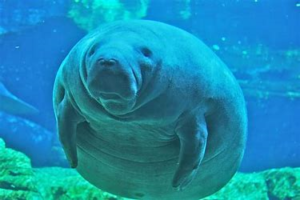
“West Indian manatees are large, gray aquatic mammals with bodies that taper to a flat, paddle-shaped tail. They have two forelimbs, called flippers, with three to four nails on each flipper. Their head and face are wrinkled with whiskers on the snout. The manatee’s closest relatives are the elephant and the hyrax (a small, gopher-sized mammal). Manatees are believed to have evolved from a wading, plant-eating animal. The West Indian manatee is related to the West African manatee, the Amazonian manatee, the dugong, and Steller’s sea cow, which was hunted to extinction in 1768. The average adult manatee is about 10 feet long and weighs between 800 and 1,200 pounds.”
They can live to 60 years old. In Florida, the population of manatees at last count in January/February 2019 was 5,733.
“Manatees need warm water to survive. In spite of their size, they have relatively little body fat, and their metabolic rate is low compared to other marine mammals. Manatees cannot tolerate temperatures below 20 ° C (68 ° F) for long periods of time. Researchers believe that individuals affected by the cold cannot produce enough metabolic heat to make up for heat loss in the environment. During winters in Florida that have been unusually cold, an increase in manatee mortality has been documented.”
“In the summer months, manatees travel freely around Florida’s rivers and coastal waters. A few manatees may range as far west as Texas and as far north as Virginia (manatees have even documented in Cape Cod, Massachusetts!), but these sightings are rare. Sporadic summer sightings in Alabama, Georgia, and South Carolina are relatively common.
In the winter, usually November through March, the manatee population is concentrated primarily in Florida. Water temperatures that fall below 21° C (70° F) cause manatees to move into warm water refuge areas. Scientists don’t know what cues manatees follow, but they seem to know when cold weather is coming and seek warm water areas.”

Leave a Reply